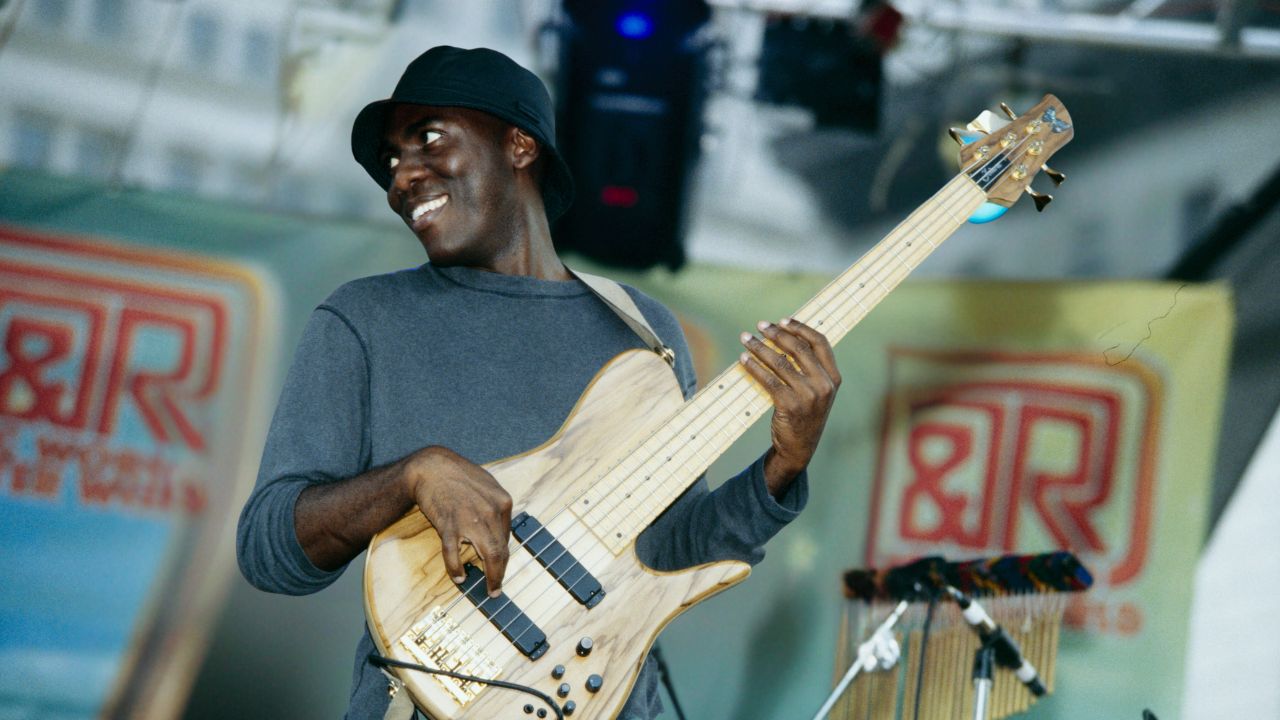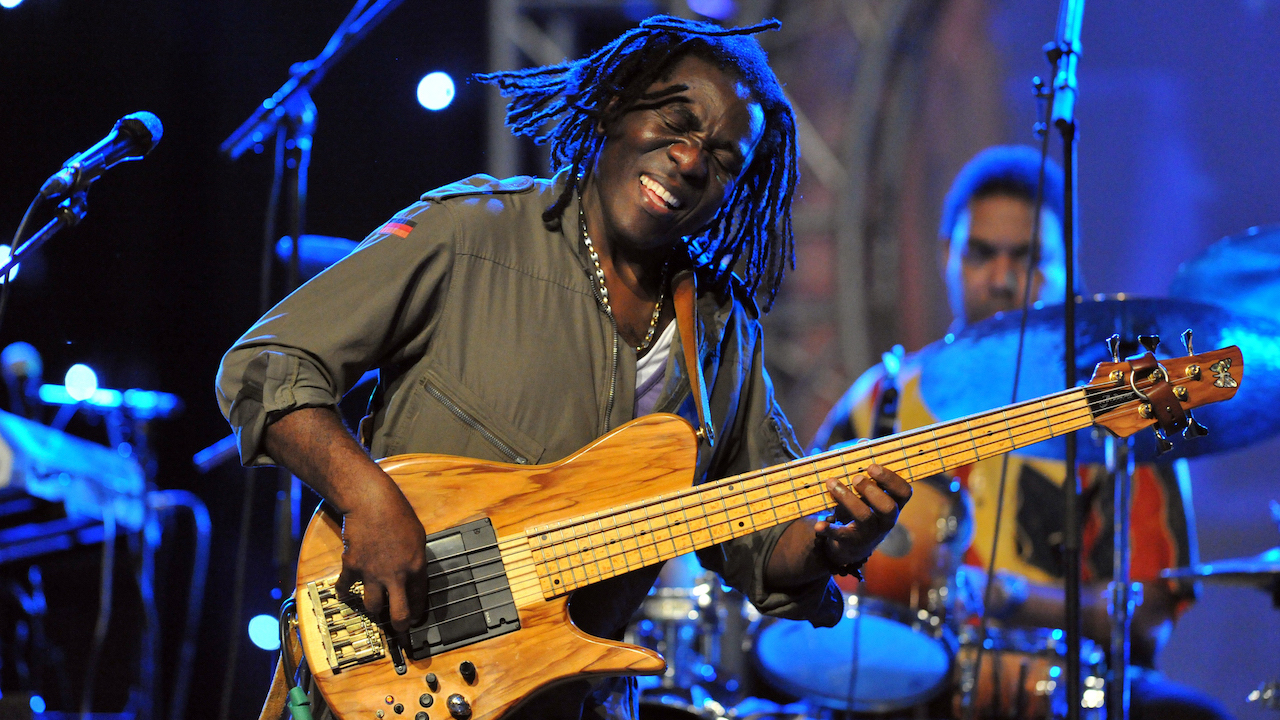
With bass in hand Richard Bona speaks many languages – but catch him in the middle of a phrase, and it's as if his notes are chosen just for your ears. Add his haunting falsetto vocals, and now you're listening to arguably the most identifiable, soul-stirring voice on the bass guitar since Jaco Pastorius.
His first instrument was the balafon – similar to a xylophone – which he learnt to play at age five. By 11, he was a guitarist in bands in Cameroon and by 14 was adept at jazz. Subsequent moves to Paris and then New York added to his story: he took up the bass following an epiphany when he first heard Jaco.
“The first time I heard Jaco, I was 14 and everything changed,” Bona told Bass Player. “I listened to every record of his I could find and I learned every note.”
While Bona's multi-layered rhythmic approach and sheer lyricism have earned him bass guitar hero status, he has also parlayed his singular vocals into a career as a globally successful solo artist, selling thousands of albums worldwide.
His 2005 effort, Tiki, served up fat fretless phrases, and ghost-note-enhanced world grooves. “I wanted to make a record about how closely Brazil and Africa are related musically, culturally, and in so many other ways. When you play Brazilian music in Africa, people start dancing right away. I wanted to sing about that relationship: the things we smell, touch, taste, and hear in our everyday lives that bring us together.”
South American influences notwithstanding, Tiki also features an intense, neoclassical version of Jaco Pastorius's Three Women orchestrated for strings. “I didn't want to record a famous Jaco song, but Gil Goldstein found this tape for me; it was just Jaco playing the tune on piano.”

In the September 2006 issue of Bass Player, Bona talked us through the ins and outs of his rhythmically intense fourth solo album, Tiki. The 15-track disc features Bona's usual cohorts, keyboardist ATN Stadwijk and drummer Vinnie Colaiuta, plus special guests like John Legend and Djavan.
Please Don't Stop
“John Legend and I did this track for Puma's collaborative album Africa Plays On. I wrote the music, and I told John that my idea for the song was about trying to convince a girl to stay. Не came up with the lyrics in an hour and then sang the hell out of it! He's an amazing musician and artist.”
Dipama
“A good example of a song I wrote on guitar that all the other parts came from. I'm singing about learning. You learn more by listening to others; most of the time it's better to be quiet and just listen.”
Tiki
“This establishes the album's theme: the connection between Africa and Brazil. Feel-wise it's sort of a baion groove with a bassline thats more makossa, and there are elements of Indian music, as well.”
O Beta O Siba
“The title means ‘up and down.’ It's a love song for a lady who is running away from a man who loves her. The groove is sort of reggae funk, which Vinnie Colaiuta embellishes with his rhythms. I palm-muted my Fodera 5-string.”
Esoka Bulu (Night Whisper)
“What every woman whispers to her lover at night, when it gets quiet. It's a jazz ballad in three with Ari Hoenig, who is the greatest brush player in the history of drums. He could sweep up all of Brooklyn in an hour!”
Listen out for Bona's ear-grabbing fretless fill behind George Colligan's piano solo at 2:18. Reaching for the chord's 9th on the downbeat, he follows up with an arpeggio that touches on 6th and 10th, as well.
O Sen Sen Sen
“I see music in colors, and I like my records to be in a lot of colors. This track combines salsa, African rhythms, and accordion from Brazil. The song is saying, ‘You ain't seen nothing yet!’”
Manyaka O Brazil
“This is the main song when it comes to telling the story of this record; the groove is very open and can go anywhere. I wrote it thinking of Djavan, and I was so blessed that he came and sang it.”
Three Women
“I didn't want to do a famous Jaco song – I wanted a surprise. Gil Goldstein found this tape for me; it was just Jaco playing the tune on piano. We came up with a feel and a string arrangement. Gil brought in the Flux Quartet and I played my fretless New York Bass Works 4-string.”
Ba Senge
“The song addresses learning about differences in order to understand others. I's pretty much a funk groove. I'm not a great slapper, but I enjoy it. I used my 1966 Fender Jazz Bass.”
Akwa Samba Yaya
“This song celebrates Black heritage in Brazil. I's a Salvadorian samba mixed with African guitar and percussion. It's my usual global affair!”
Calcabao de Copacabana
“I call this a samba cancon groove. It's what I feel inside while staying in Rio de Janeiro and walking along the beach. I made friends in Brazil on my recent visits and I wanted to record at least part of the album down there.”
Samaouma
“Samaouma is a tree in the Amazonia jungle that Indians used for many purposes. They used to communicate by hitting the tree. Musically, everything is in here: Argentinean tango, Colombian cumbia, a bit of Pat Metheny, African guitar, and even classical music.”
The blistering melody is first heard at the 2:25 mark, doubled by keyboards, violin, and Bona's voice. In addition to the terrifying tempo, the phrase's four-beat length (and four notes per beat) against the 3/4 meter adds to the tricky traversing.







